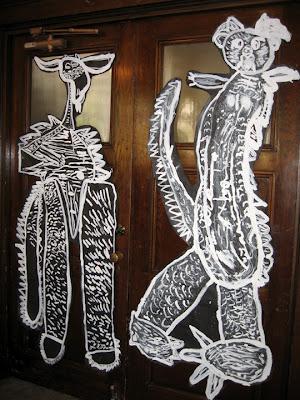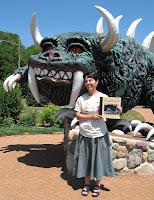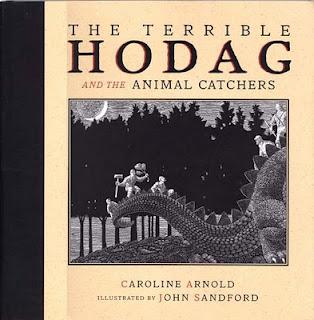 Recently, I did an author visit at Pilgrim School in Los Angeles. Before my visit, the librarian had read aloud my tall tale, The Terrible Hodag and the Animal Catchers, to the students. But she didn’t show them the illustrations in the book. Instead, the children had to imagine their own version of the creature that has the head of an OX, feet of a BEAR, back of a DINOSAUR, and the tail of an ALLIGATOR. Afterwards, the art teacher asked the first graders to paint their images. She gave them large sheets of black paper (after all, the Hodag is said to be forty feet tall!) and white paint and large brushes. They worked in small groups, each one producing an amazing, and different giant Hodag. The finished products were mounted on the walls of the room where I gave my presentation, making us feel as if we were in the north woods where the Hodag lives.
Recently, I did an author visit at Pilgrim School in Los Angeles. Before my visit, the librarian had read aloud my tall tale, The Terrible Hodag and the Animal Catchers, to the students. But she didn’t show them the illustrations in the book. Instead, the children had to imagine their own version of the creature that has the head of an OX, feet of a BEAR, back of a DINOSAUR, and the tail of an ALLIGATOR. Afterwards, the art teacher asked the first graders to paint their images. She gave them large sheets of black paper (after all, the Hodag is said to be forty feet tall!) and white paint and large brushes. They worked in small groups, each one producing an amazing, and different giant Hodag. The finished products were mounted on the walls of the room where I gave my presentation, making us feel as if we were in the north woods where the Hodag lives. I did not invent the Hodag. The first Hodag was described in a newspaper article in the northern Wisconsin town of Rhinelander in 1893. Then, in 1896, prankster Eugene Shepard, (who had instigated the earlier report) claimed to have captured a Hodag. He displayed his “living” monster at the Oneida County fair. Later, he admitted it was a hoax. Rhinelander still considers itself the home of the Hodag. When I visited Rhinelander several years ago, I had my picture taken under the huge fiberglass model of the Hodag that stands outside the Chamber of Commerce. This Hodag looks considerably fiercer than those portrayed in my books!
I did not invent the Hodag. The first Hodag was described in a newspaper article in the northern Wisconsin town of Rhinelander in 1893. Then, in 1896, prankster Eugene Shepard, (who had instigated the earlier report) claimed to have captured a Hodag. He displayed his “living” monster at the Oneida County fair. Later, he admitted it was a hoax. Rhinelander still considers itself the home of the Hodag. When I visited Rhinelander several years ago, I had my picture taken under the huge fiberglass model of the Hodag that stands outside the Chamber of Commerce. This Hodag looks considerably fiercer than those portrayed in my books! Through the years, tales of the Hodag have spread throughout the upper midwest. As with all tall tales, the stories have evolved. I first learned about the Hodag when I was a child and went to summer camp at Camp Bovey (originally called Camp Hodag) in northern Wisconsin and we told Hodag stories around the campfire at night. I remembered those stories and after I grew up and became a children’s book author I wrote one of them down. That story became The Terrible Hodag, illustrated by Lambert Davis. He depicts the Hodag as a kind of taxidermist’s assemblage of body parts.
Through the years, tales of the Hodag have spread throughout the upper midwest. As with all tall tales, the stories have evolved. I first learned about the Hodag when I was a child and went to summer camp at Camp Bovey (originally called Camp Hodag) in northern Wisconsin and we told Hodag stories around the campfire at night. I remembered those stories and after I grew up and became a children’s book author I wrote one of them down. That story became The Terrible Hodag, illustrated by Lambert Davis. He depicts the Hodag as a kind of taxidermist’s assemblage of body parts. I then took the characters from the first book and used them to create my own story. That became The Terrible Hodag and the Animal Catchers. The illustrations in that book, by John Sandford, are black and white and evoke turn of the century woodcuts.
I then took the characters from the first book and used them to create my own story. That became The Terrible Hodag and the Animal Catchers. The illustrations in that book, by John Sandford, are black and white and evoke turn of the century woodcuts.I love the way every artist, from the first graders to the illustrators of my books, has created their own unique image of the Hodag. The Hodag has come a long way from the monster that Eugene Shepard “captured” more than a century ago.
You can learn more about the origin of the Hodag in Long Live the Hodag: the life and Legacy of Eugene Shepard: 1854-1923 by Kurt Daniel Kortenhof.
